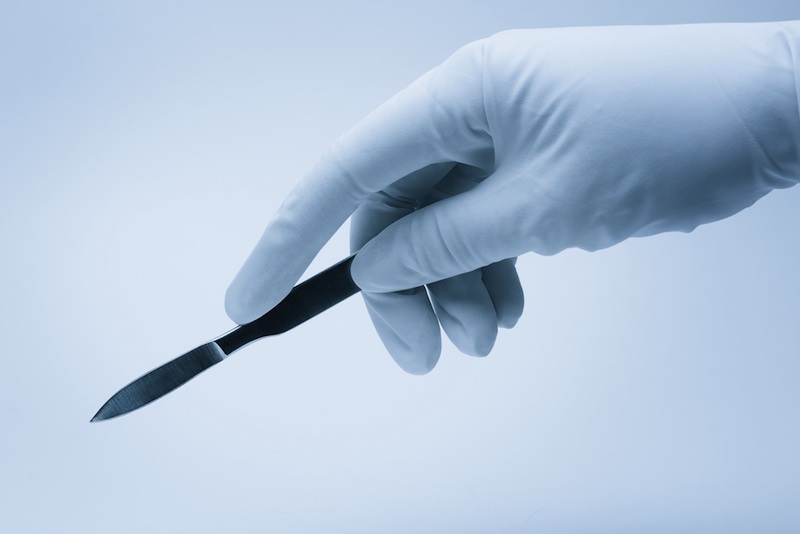
The Future of Surgery is Now: Smaller Scars, Fewer Complications (Op-Ed)

Dr. Amit Kharod is a board-certified general surgeon and chief of the Department of Surgery at CentraState Medical Center in Freehold, N.J. He specializes in surgical robotics, single-incision laparoscopic surgery (SILS), and advanced laparoscopic and general surgery. He contributed this article to Live Science's Expert Voices: Op-Ed & Insights.
Having surgery today is a vastly different experience than it was just a few decades ago. As recently as the 1990s, undergoing an operation of any kind would entail a large incision necessitating an arduous recovery that could take months. Today, doctors routinely perform even complex surgeries using a few small incisions, requiring only a day or two in the hospital for post-operative recovery. Physicians can perform many procedures as "day surgeries," in which the patient can return home the same day.
Those inroads have resulted primarily from technological advancements that support surgeons in accomplishing procedures safely, using the smallest possible incisions. The environment in which surgeons operate today continues to advance — when our children are adults, the way doctors perform operations today may seem practically antiquated.
The changes in the industry are good news for patients facing surgery. These advancements will make having an operation less invasive and therefore safer, less painful, less expensive and with fewer post-operative complications.
The following are a few of the key technologies leading the way to the future.
Single-incision laparoscopic surgery (SILS)
In contrast to the multiple entry points required by traditional laparoscopy, which necessitates about four to five half-inch to 1-inch (2.54 centimeters) incisions around the surgical area, SILS is the next phase of minimally invasive surgery, requiring just one 1.5 to 2.5-inch incision in the belly button through which a small camera and miniature surgical tools are placed.
Sign up for the Live Science daily newsletter now
Get the world’s most fascinating discoveries delivered straight to your inbox.
Today, SILS is often used for gallbladder removal and gynecological procedures. This is the final frontier of laparoscopic surgery before natural orifice surgery, in which there is no external incision. However, don't prolong any pending operation waiting for incision-free surgery; right now, "no scar" surgery is still on the drawing board.
SILS is still a specialty procedure that requires advanced training, but it is nonetheless available today in many advanced community hospital settings.
Robotics
In order to successfully perform an operation using only a few small incisions, the surgical tools need to be tiny and state-of-the-art. That's where the surgical robotic arm comes into play. Surgeons undergo specialized training to manipulate robotic arms that offer seven degrees of motion — far beyond the limits of the human hand. Equally useful to the surgeon, robotic surgical stations also include site magnification of up to 10 times the capability of the human eye.
Robotics has been instrumental in helping doctors perform highly complex and intricate surgeries with far less scarring, pain and recovery time for patients of all ages. More than 1.5 million robotic surgeries have been performed; they are ideal for delicate surgeries such as hysterectomies and prostate removal. Robotic surgeon specialists increasingly use this technology for cancer, pediatric and cardiac surgeries.
Technology to diagnose diseased tissue more accurately
Historically when surgeons operated, they relied exclusively on their eyes and surgical expertise to identify healthy tissue and bad tissue that need to be removed. But new fluorescent imaging technology can show in great detail, for example, how much of a kidney is cancerous, so the surgeon can remove just that segment of the kidney. This allows for improved precision in tumor removal.
Scintigraphy (fluorescent imaging) is an interesting example of such a diagnostic tool. For kidney cancer , a dye is injected into the patient's bloodstream, highlighting sections of the kidney that are cancerous. The surgeon, outfitted with a type of night-vision goggles, can clearly locate the highlighted tumors and remove them while preserving the healthy surrounding tissue. This results in less surgery and less trauma for the patient. Currently, scintigraphy is most commonly used by radiologists for identification of lymph nodes in breast cancer and location of intestinal bleeding points. This new application helps doctors actually observe the blood flow in real time.
Surgeons moving from teaching hospitals to community hospitals
Today and going forward, highly trained surgeon specialists are performing state-of-the-art procedures at smaller hospitals, not just at traditional, large academic teaching institutions.

The reason for this is modern healthcare economics: Many academic healthcare institutions are no longer fiscally able to offer the financial rewards they were traditionally afforded. As a result, top medical specialists are now choosing private practice or smaller community hospital settings that can attract these doctors through their aggressive acquisition of comparable facilities offered in smaller, less congested locations.
Find the right surgeon and hospital for your needs
Leading hospitals already use many of the newer technologies discussed here. Ask your surgeon if your hospital offers this technology, and if so, whether your case would be suitable for these procedures.
Confirm that your board-certified surgeon has received special training in SILS or robotics and find out how many times they have performed the operation you need. Discuss the risks of using this technology for your operation.
Finally, remember that you are purchasing an important service when you undergo surgery. You should be 100 percent confident in the surgeon's expertise and ability to get the job done successfully, safely and with as little discomfort to you as possible.
Follow all of the Expert Voices issues and debates — and become part of the discussion — on Facebook, Twitter and Google+. The views expressed are those of the author and do not necessarily reflect the views of the publisher. This version of the article was originally published on Live Science.









